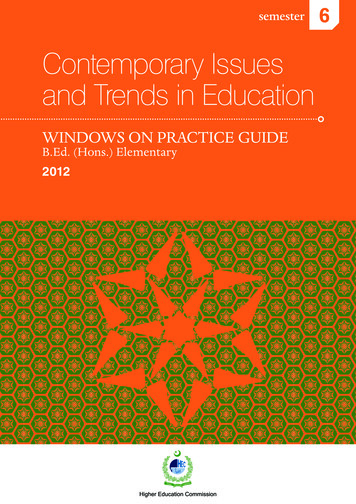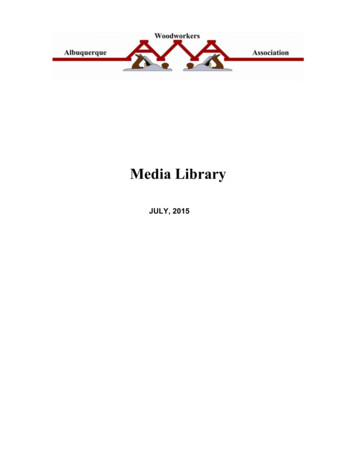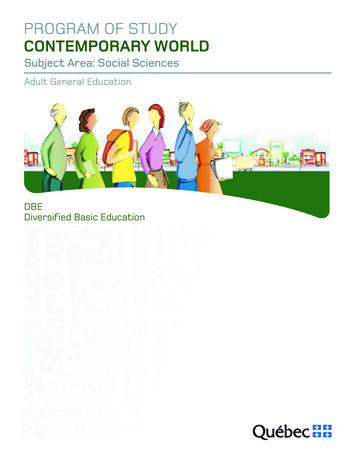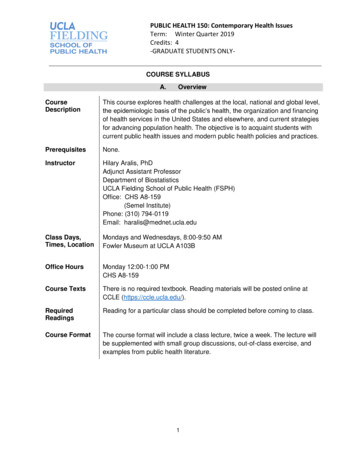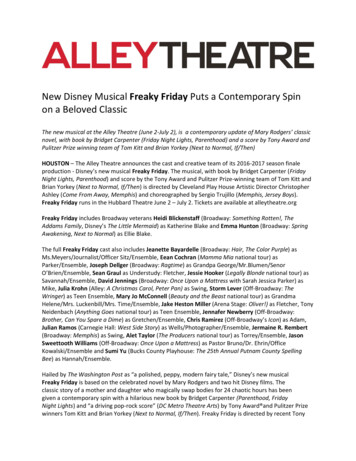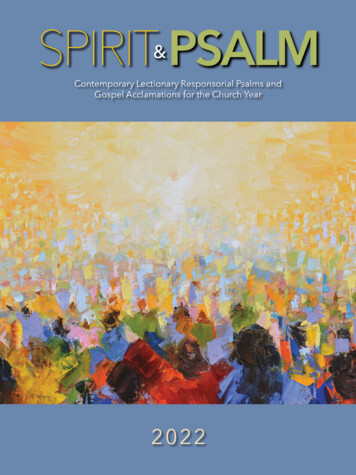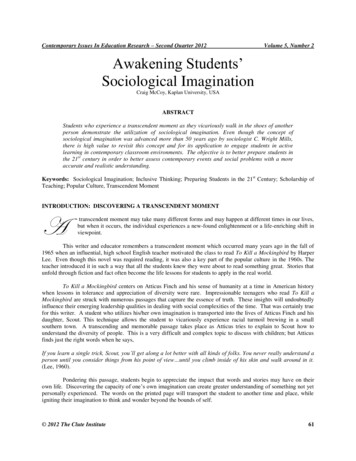
Transcription
Contemporary Issues In Education Research – Second Quarter 2012Volume 5, Number 2Awakening Students‟Sociological ImaginationCraig McCoy, Kaplan University, USAABSTRACTStudents who experience a transcendent moment as they vicariously walk in the shoes of anotherperson demonstrate the utilization of sociological imagination. Even though the concept ofsociological imagination was advanced more than 50 years ago by sociologist C. Wright Mills,there is high value to revisit this concept and for its application to engage students in activelearning in contemporary classroom environments. The objective is to better prepare students inthe 21st century in order to better assess contemporary events and social problems with a moreaccurate and realistic understanding.Keywords: Sociological Imagination; Inclusive Thinking; Preparing Students in the 21st Century; Scholarship ofTeaching; Popular Culture, Transcendent MomentINTRODUCTION: DISCOVERING A TRANSCENDENT MOMENTAtranscendent moment may take many different forms and may happen at different times in our lives,but when it occurs, the individual experiences a new-found enlightenment or a life-enriching shift inviewpoint.This writer and educator remembers a transcendent moment which occurred many years ago in the fall of1965 when an influential, high school English teacher motivated the class to read To Kill a Mockingbird by HarperLee. Even though this novel was required reading, it was also a key part of the popular culture in the 1960s. Theteacher introduced it in such a way that all the students knew they were about to read something great. Stories thatunfold through fiction and fact often become the life lessons for students to apply in the real world.To Kill a Mockingbird centers on Atticus Finch and his sense of humanity at a time in American historywhen lessons in tolerance and appreciation of diversity were rare. Impressionable teenagers who read To Kill aMockingbird are struck with numerous passages that capture the essence of truth. These insights will undoubtedlyinfluence their emerging leadership qualities in dealing with social complexities of the time. That was certainly truefor this writer. A student who utilizes his/her own imagination is transported into the lives of Atticus Finch and hisdaughter, Scout. This technique allows the student to vicariously experience racial turmoil brewing in a smallsouthern town. A transcending and memorable passage takes place as Atticus tries to explain to Scout how tounderstand the diversity of people. This is a very difficult and complex topic to discuss with children; but Atticusfinds just the right words when he says,If you learn a single trick, Scout, you’ll get along a lot better with all kinds of folks. You never really understand aperson until you consider things from his point of view until you climb inside of his skin and walk around in it.(Lee, 1960).Pondering this passage, students begin to appreciate the impact that words and stories may have on theirown life. Discovering the capacity of one‟s own imagination can create greater understanding of something not yetpersonally experienced. The words on the printed page will transport the student to another time and place, whileigniting their imagination to think and wonder beyond the bounds of self. 2012 The Clute Institute61
Contemporary Issues In Education Research – Second Quarter 2012Volume 5, Number 2Is it not possible to imagine through the story of others the meaning of prejudice and the inhumanity ofracial hatred? Might we use the human gift of imagination to teach life lessons to all children? Might we learn ofthings and events beyond our place and time by using our imagination to extract moral principles to guide usthrough the complexities of life without having first-hand experience?This writer believes an imaginative experience allows an epiphany or transcendent moment to occur. Thisaction may enable students to develop insight into social issues and strengthen their leadership skills. Students whopractice and apply the power of imagination allow themselves to transcend from a limited, local perspective to aboundless view unconstrained by geography. Being mentally transported, in order to view and appreciate anotherperson‟s worldview, is simply a matter of imagination.NEW AWARENESS OF AN OLD CONCEPTStudents may have to go out of their way before they encounter the works of sociologist C. Wright Mills(1916-1962). However, studying the writings of Mills will infuse clarity with an ability to synthesize other theoriesand perspectives into a finer focus. This new focus can yield valuable insights into the scholarship of teaching andlearning.Back in the 1950s, Mills was out of the mainstream of academia, yet he produced a brilliant body of workthat became a significant contribution to sociology. Mills wrote a trilogy on social stratification - The New Men ofPower, White Collar, and The Power Elite. He culminated his writing career with The Sociological Imaginationwhich provides a foundational basis for this article.SOCIOLOGICAL IMAGINATION – A QUALITY OF MINDMills (1959) describes sociological imagination as simply a “quality of mind” that allows one “to grasphistory and biography and the relations between the two within society.” A sociological imagination is the ability toview one‟s own society as an outsider would, rather than only from the perspective of personal experience andcultural biases (1959, p.6). Mills offers a promise to the person who adapts a sociological imagination. Thispromise is an “ability to understand the larger historical events of society so that individuals can understand theirown experience and gauge their own fate by imagining how others in society act and feel” (p.5). The ability to useour sociological imagination is exactly what Atticus Finch asks Scout to do:You never really understand a person until you consider things from his point of view until you climb inside of hisskin and walk around in it. (the words of Atticus Finch) to view one’s own society as an outsider would ( the words of C. Wright Mills)In order for students to better understand their local and global neighbors, educators need to encouragestudents to suspend their own personal bias of how they view others. Instead, there is value in teaching students touse their minds to imagine walking in another person‟s shoes. Students using a sociological imagination canachieve greater insight and perspective into other societies and cultures.KEY LESSONS FROM MILLSIt is in the present that the sociological imagination can be applied to the understanding and solutions foundin contemporary social problems (Mills, 1959). This was true then and is certainly still true today. Awakening asociological imagination and utilizing these qualities is a valuable skill for students to learn as they become betterprepared to navigate through a complex 21st century world.Another theme that C. Wright Mills (1959) developed is the usefulness of sociology, not just as someacademic discipline to be studied but how a general working knowledge of sociology can assist the average studentor the trained social scientist to become a better observer of social events and, thus a more enlightened and informedcitizen. Mills recognizes that the social events of the world are often viewed as a tangled-up mess of factual errors62 2012 The Clute Institute
Contemporary Issues In Education Research – Second Quarter 2012Volume 5, Number 2and unclear conceptions. Only after those events “have been logically untangled is it possible to know whetherissues really do involve a conflict of values” (p.77). The task of untangling the multi threads of society is the job ofa teacher. Mills argues that the teacher‟s job is “to reveal to students as fully as he can just how a supposedly selfdisciplined mind works.” In this sense, “the art of teaching is, in considerable part, the art of thinking out loud butintelligibly” (p.79). Mills does not define the teacher solely as the professional teacher found in the traditionalclassroom and he does not imply that the teacher is the only individual responsible for the role of creating in others a„self-disciplined mind.‟ Rather, Mills says everyone can develop the qualities of a sociological imagination and usetheir own creative teaching skills to assist others in the „art of thinking out loud but intelligibly.‟ Again, drawingfrom the beginning illustration from To Kill a Mockingbird, we can more clearly see how Atticus Finch is teachinghis daughter, Scout, to use her sociological imagination to appreciate and understand human behavior and societalissues. The capacity and usefulness of sociological imagination is within us all as we teach and lead others.The sociological imagination is such a simple yet captivating concept. It is nothing new or revolutionary,but C. Wright Mills describes the concept and crafts a simple methodology which can be used by social scientists,leaders, teachers, and parents attempting to explain seemingly complicated social issues.Mills (1959) contends that “no one is outside society – the question is where each stands within it” (p.184).Even though there are inescapable problems in becoming a part of the decision-making process, the key inovercoming the problem is to “help the individual to become a self-educating man” (p. 184). Mills recognizes thateven during his era, society was facing the possibility that “the human mind, as a social fact, might be deterioratingin quality and cultural level” (p.175). The additional discouraging fact is that American society may not even noticethis deterioration of the mind because of conspicuous accumulation of technological gadgets and consumer goodsduring the economic boom of post-war expansion. In other words, the material stuff we possess may distract us fromcritical thinking and thoughtful discourse. Mills‟ view of American society in 1959 was not very optimistic. Thedeterioration of mind in the average citizen today would be even more acute based on Mills‟ assertion thataccumulation and preoccupation with things would dull or deteriorate the mind. Most would agree that today thereis an imperative and immediate need for students to broaden their skills in order to meet the needs and demands thatare playing out on the global stage. No doubt, people from all corners of our global community are moreinterconnected today than ever before in human history, yet there is strong evidence that people are increasinglybecoming more self-absorbed and less knowledgeable in global matters.AWAKENING THE POWER OF SOCIOLOGICAL IMAGINATIONWhat can be done? How can students of today benefit from the lessons of C. Wright Mills many yearsago? The answer may lie in awakening the power of our sociological imagination. Utilizing this power spansgeographical/cultural borders and adapts to societal events of today and of the future. Mill‟s challenge is for allstudents - young and old - to educate themselves with a broad multi-knowledge in the social sciences and view allsocieties through the lens of a sociological imagination. The purpose of this article is to encourage educators toignite and awaken a sociological imagination within their students and use it as a teaching tool to inspire and leadothers, just like Atticus Finch sparks the imagination of his daughter to think about another human being by askingher to “climb inside of his skin and walk around in it.”PREPARING STUDENTS FOR THE 21ST CENTURYThe concept of sociological imagination offers a link between what we learn and its application to the realworld. Every person has a role as an educator. This role is not exclusive to professional educators. All citizenshave a deep responsibility to teach others, both young and old, about societal development and social problems, aswell as how to apply knowledge through service to others. The ability to do this is even more imperative in the 21 stcentury because we now understand that all people around the world are intrinsically interrelated. Perhaps morethan ever, educators need to create learning environments in which students can exercise the use of theirsociological imagination as they expand their vision of others locally as well as globally. It is with a sociologicalimagination that students can transcend borders and begin to understand how others perceive the same world events.Gardner (2009) advocates the importance of seeking transcendent moments and expanding consciousness ofwholeness. This quality resonates well with the value of awakening sociological imagination. 2012 The Clute Institute63
Contemporary Issues In Education Research – Second Quarter 2012Volume 5, Number 2CONNECTIONS AND SUPPORT FROM CONTEMPORARY RESEARCHERSNarrative ImaginationThe words of Heater (2002) and Kingwell (2001) squarely tie into the words of C. Wright Mills (1959) inaddressing a student‟s lack of interest, boredom, and the difficulty to engage in what Heater refers to as the“narrative imagination.” The narrative imagination is the ability to read or listen to the words of theorists,historians, and other social scientists. Most students find the narrative form of learning to be the boring stuff oftraditional education. Reading an endless text does not engage students into an active mode. However, awakeningstudents‟ sociological imagination with the narrative imagination will engage them into an active learning mode inwhich they can now read and explore how others view a particular issue, and also be transported in time and spaceso they can vicariously “walk in the shoes of another person.” Creating this type of inquiry into global thinking is aworthy endeavor of a well prepared education system.Capacity of Human ImaginationPhilips (1972) examines the capacity of the human imagination. Modern humans have a tremendousadvantage in “our ability to move outward conceptually to encompass an ever-expanding number of forces whichaffect a given phenomenon and to reach far back into the past to gain perspective for reaching ahead into the future”(p. 3). These words offer a complement to the foundation of sociological imagination, as created by Mills, andexpand a student‟s ability to examine the past in order to gain a clearer view of the future. When imagination isbased on a broad knowledge base, it can serve as a useful predictor of the future and can allow students tovicariously envision how to act and respond in a positive and meaningful way.Inclusive ThinkingJanet J. McIntyre-Mills (2000) discusses many elements of social thinking. Her ideas add to the theme ofawakening a sociological imagination. The main goal is a convincing argument on the importance of “inclusivethinking” (p. 2). Inclusive thinking is defined as a thinking tool that can enhance a person‟s ability to trace commonwebs of meaning across the separate frameworks of cultural and social values. McInyre-Mills (2000) argues thatinclusive thinking can be taught. Students can be educated to work with ideas and assumptions beyond the boundsof their traditional locus of thought. In this manner, thinking tools, such as a sociological imagination, can also betaught and allow individuals to have confidence in their ability to imagine and thoughtfully peek through themetaphorical curtains that separate societies and groups. Thinking tools and communication skills help individualssort out and rework the categories that limit our thinking. Educators demonstrating and applying thinking tools, likeinclusive thinking, offer students an ability to forge transcultural webs which enrich their learning experience.McIntyre-Mills (2000) urges us to “think about our thinking” in order to develop a realization that abalance between diversity and commonality is essential ” (p.74). C. Wright Mills (1959) offers “the promise” thatthe sociological imagination will “enable its possessor an ability to understand his own experience and gauge hisown fate only by locating himself within his period and becoming aware of all individuals in his circumstances”(p.5). Both are asking society to foster within its citizenry a quality of humanity and inclusiveness, much like thatfound in the lessons taught by Atticus Finch to his daughter, Scout, in To Kill a Mockingbird.LESSONS TO APPLY AND CONCLUDING THOUGHTSThe intent of this article is to ignite a new awareness on the concept of a sociological imagination as athinking tool to better prepare students for the complexities of the 21 st century. Awakening a sociologicalimagination not only enhances a student‟s capacity to empathetically understand and appreciate another person‟splight, but, more importantly, it expands a conversation that elevates private troubles into public issues. The realityis that societies - from local to global levels - need to actively engage in efforts to develop and prepare a student‟sglobal mentality. The challenge is for educators to nurture a student‟s mentality to actively listen to the stories ofothers, to vicariously walk in another person‟s shoes, and to learn crucial life lessons through their own transcendentmoment.64 2012 The Clute Institute
Contemporary Issues In Education Research – Second Quarter 2012Volume 5, Number 2To achieve this deeper insight, educators need to create learning activities that allow students to awakenand utilize a sociological imagination to transport themselves through space and time in order to “get inside the skinof another person and walk around.” Through the power of their minds, they can begin to free themselves from theconstraints, often clouded with bias and prejudice, to explore a world of human commonality.There is not a prescriptive model to follow in awakening one‟s sociological imagination, nor is oneperson‟s transcendent moment better than another person‟s epiphany in appreciating the situation or plight ofanother person. This article began with an account of how this writer‟s imagination was ignited by reading thenovel To Kill a Mockingbird. Through popular culture, the arts, literature, film, music, theatre, and simply being akeen observer of human interaction, all students can find sufficient stimulus to spark a transcendent moment. Welive in a complex world - one that challenges everyone to become even more mindful of their own transcendentmoments when their sociological imagination awakens.AUTHOR INFORMATIONCraig McCoy is a Kaplan University online professor in the graduate School of Business and Management. Hisexpertise is in the study of leadership and organizational change with a qualitative research methodology. He servesas a mentor, course lead, and course developer. E-mail: cmccoy2@kaplan.edu.REFERENCES1.2.3.4.5.6.Gardiner, J. (2009). Transcendent Leadership: Board metrics for profits, people, and planet. (Scholarlypaper presented at the annual meeting of the International Leadership Association, Prague, CzechRepublic). November 12, 2009.Heater, D. B. (2002). World citizenship: cosmopolitan thinking and its opponents. New York: Continuum.Kingwell, M. (2001). The world we want: restoring citizenship in a fractured age. Landham, Maryland:Rowman & Littlefield Publishers.McIntyre-Mills, J. J. (2000). Global citizenship and social movements: creating transcultural webs ofmeaning for the new millennium. Amsterdam: Harwood Academic.Mills, C.W. (1959). The Sociological Imagination. New York: Oxford University Press, Inc.Phillips, B. S. (1972). Worlds of the future - exercises in the sociological imagination. Columbus, Ohio:Charles E. Merrill Publishing Company. 2012 The Clute Institute65
Contemporary Issues In Education Research – Second Quarter 2012Volume 5, Number 2NOTES66 2012 The Clute Institute
Craig McCoy, Kaplan University, USA ABSTRACT Students who experience a transcendent moment as they vicariously walk in the shoes of another person demonstrate the utilization of sociological imagination. Even though the concept of sociological imagination was advanced more than 50 years ago by sociologist C. Wright Mills, there is high value to .

